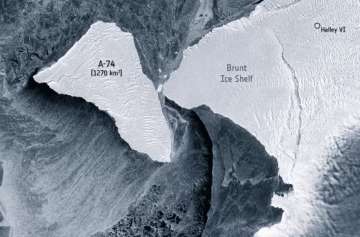A massive iceberg, nearly the size of Greater London, has brushed past the coast of Antarctica. The A-74 iceberg has been floating in Antarctica's Weddell Sea and has remained close to the shelf due to ocean currents that spun it around the western tip of Brunt. According to the details, the A74 iceberg is made just a faint contact with the coast, with reports saying it would probably have knocked off a similarly sized iceberg had it been any firmer.
Scientists in the United Kingdom have been keeping a close watch on the icy liaison because one of their bases is nearby.
According to a report with the BBC, Dr. Ollie Marsh from the British Antarctic Survey said they've been monitoring the situation very closely for the past six months because A74 has been drifting around in the same kind of area.
"But then there were some really strong easterly winds and these seemed to trigger a rapid movement in A74 that saw it scrape along the edge of the western Brunt," he said.
The Brunt is what's called an ice shelf. It's an amalgam of glacier ice that has flowed off the land and floated out to sea.
It's still attached to the train of ice behind - but only just. An enormous crack, called Chasm 1, has opened up in recent years in the shelf's far-western sector. An area measuring some 1,700 sq km is on the verge of breaking free.
Many thought a big nudge from the passing A74 iceberg might be the event that made it all happen. But it didn't; or at least, it hasn't happened yet.
Meanwhile, the European Space Agency (ESA) has captured radar images of the movement of the iceberg, which is 1,270 square kilometres in size.
The iceberg remains attached in the vicinity of McDonald Ice Rumples, where the ice shelf is grounded on the seabed amid reports of minor impact.
Also Read | Indian Ocean warming at faster pace, India to witness increased heat waves, flooding: Report
Latest World News

